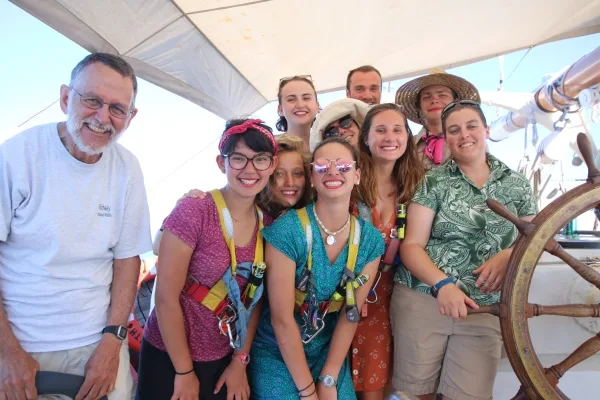News
Swim Call on the Cramer

Ship’s Log
Current Location
18° 23.56’ N x 075° 01.08’ W
Ship’s Heading and Speed
Hove To!
Weather
Clear skies and light wind on the leeward side of Navassa Island.
We are currently anchored outside of Navassa Island, which is an interesting geological feature: a plateau of limestone with eroded cliffs that meet the sea. The island is covered in shrubbery, and from the boat we could see the remains of an old stone road, and some building ruins. The island is not inhabited, though ownership has been greatly contested over the years between the United States and Haiti. It is home to a large bird population, and number of feral cats and dogs.
The island appeared on the horizon at 0300, but we waited until daylight to sail in. Earlier this morning, we encountered a Haitian fishing boat that was in need of fuel and food. We were able to resupply them, and wish them a safe passage home.
The morning was filled with a number of scientific deployments. We completed surface stations at 2 locations around the island which was a unique opportunity for a SEA vessel, as the Windward Passage is usually far too windy to stop for deployments.
This afternoon, everyone on board put on their cleaning gloves for the weekly Field Day, which is when the entire ship gets turned inside- out and cleaned. It makes for a long afternoon, but we make the most of it with music and good company.
Our cleaning frenzy was rewarded with the first swim call of the trip! The past few weeks of sailing bright, Caribbean waters without being able to swim has been a bit of a tease, but Cap finally gave the word. Either we earned it, or were all too smelly and needed a bath. Regardless, spirits are high. Now, we make for Jamaica with clean bodies, spirits, and ship.
Life on Cramer often follows this ebb and flow: long days are contrasted with happy evenings on the quarter deck, full bellies, and the occasional whale or dolphin sighting. Yesterday, our afternoon watch ended with a pod of twenty dolphins riding our bow wave.
The whole Watch piled into the head-rig to watch the dolphins swim below us. They are like hummingbirds through the water.
Over the coming weeks, we will be relying less on modern navigation techniques and begin to hone in on other navigating skills: celestial and dead reckoning. It adds a new challenge, but all seem eager to sink their teeth into something new.
– Abigail Colby, A Watch, University of New Hampshire
P.S. Hi Mom, Dad, Granddad, Grammy, and Griffin! I think of you all often and will be seeing you soon. Much love!